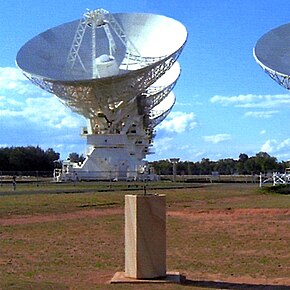Observatory
 | |
| Alternative names | Narrabri Observatory |
|---|---|
| Named after | Paul Wild |
| Location | Narrabri, New South Wales, Australia |
| Coordinates | 30°18′50″S 149°33′43″E / 30.314°S 149.562°E / -30.314; 149.562 |
| Website | www |
| Telescopes | |
 | |
| [edit on Wikidata] | |
The Paul Wild Observatory, also known as the Narrabri Observatory and Culgoora Observatory, is an astronomical research facility located about 24 km west of Narrabri, New South Wales, Australia. It is the home of the Australia Telescope Compact Array, and the Culgoora Solar Observatory.
The site itself and the Australia Telescope Compact Array are run by Australia's science agency, the CSIRO. The current Solar Observatory is run by the Space Weather Services section of Australia's Bureau of Meteorology.
The site is named in honour of Australian radio astronomer Paul Wild, who headed the team that built the instrument that the site was established for – the Culgoora Radioheliograph, the world's first radioheliograph – which ran from 1967 to 1984.
The Australia Telescope Compact Array began operating at the site in 1988.
Current facilities
- The Australia Telescope Compact Array – a six-dish radio telescope interferometer
- The Ionospheric Prediction Service (Space Weather Services) Culgoora Solar Observatory
- A node of the Birmingham Solar Oscillations Network (BiSON)
- An element of the Magnetic Data Acquisition System (MAGDAS) global magnetometer array
-
 Four antenna dishes of the Compact Array.
Four antenna dishes of the Compact Array.
-
Dishes of the Compact Array, showing track.
-
 A compact arrangement of dishes, at the north spur junction.
A compact arrangement of dishes, at the north spur junction.
-
 East-west track of Array, before construction of north spur. 6th dish in far distance.
East-west track of Array, before construction of north spur. 6th dish in far distance.
Past facilities
- The Culgoora Radioheliograph
- The CSIRO Culgoora Solar Observatory
- The Sydney University Stellar Interferometer (SUSI)
In the media
The children's/teen's television adventure series Sky Trackers was filmed at the site in 1993, with the antenna dishes of the Australia Telescope Compact Array being prominently featured.
Other sites nearby
In addition to the Paul Wild Observatory, there is a history of astronomical research at other sites in the Narrabri area. The Narrabri Stellar Intensity Interferometer (NSII), the predecessor of SUSI, was located about 10 km north of Narrabri.
At a site south of Narrabri, near the Bohena Creek, Durham University ran gamma ray telescopes from 1986 to 2000. The Bohena Creek site had previously been used for Sydney University's Giant Air Shower Recorder (SUGAR) for the detection of cosmic rays.
See also
References
- ^ "Visitors Guide to the Narrabri Observatory". CSIRO Australia Telescope National Facility. 30 August 2019. Retrieved 28 February 2021.
- "Narrabri, Paul Wild Observatory". www.csiro.au.
- "About SWS". Australian Government Bureau of Meteorology Space Weather Services. Retrieved 6 March 2021.
- ^ "Culgoora Observatory". Australian Government Bureau of Meteorology Space Weather Services. Retrieved 28 February 2021.
- Stewart, Ronald; Wendt, Harry; Orchiston, Wayne; Slee, Bruce (2011). "A Retrospective View of Australian Solar Radio Astronomy 1945-1960". In Orchiston, Wayne (ed.). Highlighting the History of Astronomy in the Asia-Pacific. Springer. p. 589. ISBN 978-1-4419-8160-8.
- "Radio astronomy – observing explosions on the sun". CSIROpedia. 18 April 2013. Retrieved 28 February 2021.
- CSIRO. "Australia Telescope Compact Array". www.csiro.au. Retrieved 5 September 2021.
- "Australia Telescope Compact Array". www.narrabri.atnf.csiro.au. 8 July 2019.
- "Travel to Narrabri". www.narrabri.atnf.csiro.au.
- "Australian novelist writes about life at University of Birmingham's solar observatories". www.birmingham.ac.uk.
- "Information for the Public". www.narrabri.atnf.csiro.au. 31 July 2020. Retrieved 28 February 2021.
- Yomoto, Kiyohumi (November 2005). "MAGDAS_Project". International Centre for Space Weather Science and Education Kyushu University. Archived from the original on 31 July 2007. Retrieved 4 March 2021.
- Labrum, N. R. (25 August 1972). "The Culgoora Solar Radio Observatory". Solar Physics. 27 (2): 496–504. Bibcode:1972SoPh...27..496L. doi:10.1007/BF00153122. S2CID 122609617.
- "Australia Telescope Compact Array". CSIROpedia. 5 September 2014. Retrieved 28 February 2021.
- The SUSI (Sydney University Stellar Interferometer), Narrabri,... | Download Scientific Diagram
- Watson, Fred; Couch, Warrick (December 2017). "Astronomy in Australia" (PDF). The Messenger (170). European Southern Observatory: 4. "While SUSI achieved an excellent track record in high-resolution optical astronomy, it eventually closed in the face of competition from ESO’s Very Large Telescope Interferometer (VLTI) and other facilities."
{{cite journal}}: CS1 maint: postscript (link) - Wallace, Alex (August 1993). "CSIRO - sky tracking across the universe and our television screens" (PDF). CoResearch - CSIRO's Staff Newsletter (354): 8.
- Davis, John; Lovell, Bernard (2003). "Robert Hanbury Brown 1916-2002". Historical Records of Australian Science. 14: 4.
- ^ Mark R, Dickinson (October 1997). "Chapter 3: The University of Durham Atmospheric Cerenkov Telescopes". Very high energy gamma ray observations of southern hemisphere blazars (Ph.D. thesis). Durham University. p. 41.
- "Gamma-Ray Astronomy Group | History | Australia". Durham University. Retrieved 1 March 2021.
External links
- Narrabri Observatory Public Information (CSIRO)
- Australia Telescope Compact Array - Fast Facts (CSIRO)
- Space Weather Services (IPS) Culgoora Solar Observatory (Australian Bureau of Meteorology)
- Birmingham Solar Oscillations Network (University of Birmingham)
- MAGDAS (Kyushu University)
- Paul Wild (1923-2008) (CSIROpedia)
- "A New Look at the Sun", a CSIRO film on the Culgoora Radioheliograph (CSIROpedia)
- "The Sun – Our Nearest Star", a CSIRO film on the CSIRO Culgoora Solar Observatory (CSIROpedia)

